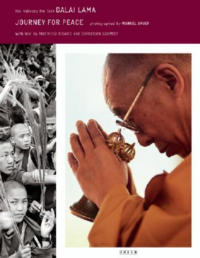 Journey for Peace
Journey for Peace

His Holiness the 14th Dalai Lama
The Pictorial Portrait Project
A project under the patronage of The Private Office of His Holiness the 14th Dalai Lama
The 14th Dalai Lama's non-violent engagement for Tibet and for peaceful cohabitation places His Holiness among the most outstanding personalities of our time. The Pictorial Portrait Project by Swiss photographer Manuel Bauer builds a comprehensive visual archive of His Holiness the 14th Dalai Lama and makes its photographs available for future generations.
The visual memory has a continuing influence on man, building and strengthening his identity. Thus the archive aims to preserve a coherent body of photographic work of the 14th Dalai Lama, with the goal of building and strenghtening the identity of the Tibetan people as well as of men around the world and future generations.
Man has the right to thorough visual documentation of outstanding personalities. His Holiness the 14th Dalai Lama is one of the most distinguished individuals of our time. His Holiness' non-violent engagement for Tibet and for peaceful cohabitation place his life story in the ranks of those of Mahatma Gandhi and Martin Luther King.
Through visual representations exemplary personalities continue to inspire and strengthen man. Photography is perfectly suited to document historically relevant events and personalities and will be valid in the future, as newly gained insights will allow new interpretations of the illustrated events.
Mankind – and especially younger generations – have the right to a coherent visual document of the 14th Dalai Lama. Such a document will make the character of this man who shapes history approachable.
His Holiness granted Swiss photographer Manuel Bauer unprecedented access to achieve the project's goal. Manuel Bauer started documenting His Holiness' life in 2001.
To ensure long-lasting archival quality, the photographs are shot predominantly in black and white and processed and stored using latest technology. Large parts of the images are digitized in high-resolution and are available for research in a digital database. The state-of-the-art processing guarantees both analog conservation and digital storage. A suitable amount of photographs is shot in color.
The archive of original negatives is available to researchers upon request.
All photographs intended for publication are presented for approval to His Holiness the 14th Dalai Lama.
The first three years of The Pictorial Portrait Project starting in 2001 were funded by the Volkart Foundation, Winterthur, the Hamisil Foundation, Zurich, Eisuke Wakamatsu, Tokyo, and Manuel Bauer. The generous commitment of the Volkart Foundation made possible the publication of the book „His Holiness the 14th Dalai Lama – Journey for Peace“. In 2005 His Holiness granted Manuel Bauer permission to continue documenting his life.
|
|
Photographer Manuel Bauer has photographed the Dalai Lama for years. The privileged access granted him by His Holiness and his entourage have enabled Bauer to offer us these powerful images, oscillating between the spiritual and the personal, the public and the intimate, the epic and the anecdotal. About the Swissborn photographer the Dalai Lama says: “Manuel Bauer is more than simply a professional: he is a close friend of mine. He also knows a great deal about Tibet, about the Tibetan community, and he has spent years making himself familiar with our culture. He understands Tibet comprehensively, as he does the exile community; and he knows me very well too. It is this knowledge that allows his pictures to say so much about their subjects.” Bauer paints a unique and irreplacable portrait of one of the most remarkable figures in recent history. And the book contains numerous quotes from and interviews with the Dalai Lama, plus a full timeline about Tibet’s yesterday and today.
”From the early morning until late into the night, and even in our dreams, we experience all kinds of perceptions. We go from being relaxed to being anxious, we feel sometimes anger, sometimes desire, sometimes compassion. Those are transitory states of mind that come and go, from moment to moment. But there must indeed be something that is aware of all this, a continuity of cognition that keeps on experiencing it even after we fall asleep. Yet that something is usually hidden to us, as if behind a curtain. So we need to remove that curtain.”
”Promoting science is very important. After all, it is looking for the same thing as Buddhism: the truth! I am more and more convinced that Buddhist monks, too, should study modern science. They could use science to help understand the nature of atoms and quarks, which would in turn help them to grasp the physical aspects of the Buddhist definition of the transitory nature of all things. That is very important. On the other hand, modern science is not very advanced in the understanding of consciousness, although consciousness, or awareness, is a major physical aspect.” |